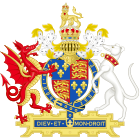Third Succession Act
 | |
| Citation | 35 Henry 8 c.1 |
|---|---|
| Territorial extent | Kingdom of England |
| Dates | |
| Royal assent | July 1543 |
| Repealed | 1603 |
| Other legislation | |
| Relates to | |
Status: Repealed | |
| Text of statute as originally enacted | |
The Third Succession Act of King Henry VIII's reign, passed by the Parliament of England in July 1543, returned his daughters Mary and Elizabeth to the line of the succession behind their half-brother Edward. Born in 1537, Edward was the son of Henry VIII and his third wife, Jane Seymour, and heir apparent to the throne.
History[]
Title and dating[]
The Act was formally titled the Succession to the Crown Act 35 Hen. 8 c.1, and is also known as the Act of Succession 1543. The royal assent was given to this bill in the spring of 1544 at the conclusion of the 1543/1544 Parliament, but until 1793 acts were usually backdated to the beginning of the session of Parliament in which they were passed. (The Act is also often dated 1544.)
Relationship to First and Second Succession Acts[]
The Third Succession Act superseded the First Succession Act (1533) and the Second Succession Act (1536), whose effects had been to declare bastards Henry's daughters Mary and Elizabeth, and to remove them from succession to the throne. This new act returned both Mary and Elizabeth to the line of succession behind Edward, any potential children of Edward, and any potential children of Henry by his then wife, Catherine Parr, or any future wife Henry might have.
With the 1536 Act, Henry VIII was authorised to dispose of the Crown by letters patent or by will, in default of any legitimate heirs. Mary and Elizabeth, who had both been declared illegitimate and incapable to inherit, expressly remained so in the 1543/44 Act; they were only capacitated to succeed to the Crown (with several provisos, such as they could not marry without the Privy Council's approval). This meant that the place in the succession of Mary and Elizabeth remained doubtful. Henry's actual will (1547) simply confirmed their position as outlined in the 1543/44 statute.
Historical effect[]

The Treason Act 1547 made it high treason to interrupt the line of succession to the throne established by the Act of Succession. Edward VI meant to bypass this Act in his "Devise for the Succession", issued as letters patent on 21 June 1553, in which he named Lady Jane Grey as his successor.[1][2] Prevailing over Lady Jane Grey, Mary ascended the throne under the terms of the Third Succession Act.
See also[]
Notes[]
- ^ "Edward VI: Devise for the Succession—1553". Luminarium: Encyclopedia Project. 2010.
- ^ Dale Hoak. "Edward VI (1537–1553)". Oxford Dictionary of National Biography. Oxford University Press, 2004; online edn, Jan 2008. Retrieved 2010-04-04. (subscription required)
Further reading[]
- Ives, E. W. (2008). "Tudor Dynastic Problems Revisited". Historical Research. 81 (212): 255–279. doi:10.1111/j.1468-2281.2007.00418.x.
External links[]
- Jokinen, Anniina (16 June 2011). "The Third Act of Succession, 1544" (Abridged ed.). Luminarium. 35 Henry VIII, Cap. 1. 3 S. R. 955.
- Aitken, Don. "Act Fixing the Succession" (Abridged ed.). 1544. 35 Henry VIII. c. 1. 3 S. R. 955. Archived from the original on January 6, 2010.
- 1543 in law
- 1543 in England
- Acts of the Parliament of England
- Succession to the British crown
- Succession acts
- Edward VI of England
- Mary I of England
- Elizabeth I